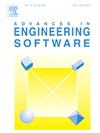Time-varying mesh stiffness calculation by a novel loaded tooth contact analysis model considering EHL contact for face-gear drive
IF 5.7
2区 工程技术
Q2 COMPUTER SCIENCE, INTERDISCIPLINARY APPLICATIONS
引用次数: 0
Abstract
Time-varying mesh stiffness (TVMS) is one of the primary excitations in dynamics. This study presents a novel loaded tooth contact analysis (LTCA) model to calculate the TVMS of face-gear drives under elastohydrodynamic lubrication (EHL) contact conditions. The effect of EHL on TVMS is considered by incorporating film thickness and oil film deformation into the LTCA model, with these parameters obtained through the non-Newtonian thermal EHL model developed in this study. Face-gear drives often operate under multiple tooth pair engagements, meaning that the external load on each tooth pair is unknown prior to solving the LTCA model. However, the external load is an input parameter for solving the EHL model. To account for the interaction between the LTCA and EHL models, the LTCA model is coupled with the EHL model and solved iteratively through numerical methods. In the iterative process, an artificial neural network (ANN) is used to replace the EHL model, enhancing computational efficiency. The proposed method is validated and applied to a face-gear drive to calculate TVMS. The results show that neglecting EHL leads to an overestimation of TVMS. Additionally, parametric analyses reveal that torque, speed, and certain lubricant properties influence TVMS.
考虑面齿轮传动EHL接触的加载齿接触分析模型计算时变啮合刚度
时变网格刚度是动力学中的主要激励因素之一。提出了一种新的加载齿接触分析(LTCA)模型,用于计算弹性流体动力润滑(EHL)接触条件下面齿轮传动的TVMS。通过将油膜厚度和油膜变形纳入LTCA模型来考虑EHL对TVMS的影响,这些参数通过本研究建立的非牛顿热EHL模型获得。面齿轮传动通常在多个齿对啮合下工作,这意味着在求解LTCA模型之前,每个齿对上的外部载荷是未知的。然而,外部载荷是求解EHL模型的输入参数。为了考虑LTCA模型和EHL模型之间的相互作用,将LTCA模型与EHL模型耦合,并采用数值方法进行迭代求解。在迭代过程中,采用人工神经网络(ANN)代替EHL模型,提高了计算效率。并将该方法应用于一个面齿轮传动的TVMS计算。结果表明,忽略EHL会导致TVMS的高估。此外,参数分析还揭示了扭矩、速度和某些润滑剂特性对TVMS的影响。
本文章由计算机程序翻译,如有差异,请以英文原文为准。
求助全文
约1分钟内获得全文
求助全文
来源期刊

Advances in Engineering Software
工程技术-计算机:跨学科应用
CiteScore
7.70
自引率
4.20%
发文量
169
审稿时长
37 days
期刊介绍:
The objective of this journal is to communicate recent and projected advances in computer-based engineering techniques. The fields covered include mechanical, aerospace, civil and environmental engineering, with an emphasis on research and development leading to practical problem-solving.
The scope of the journal includes:
• Innovative computational strategies and numerical algorithms for large-scale engineering problems
• Analysis and simulation techniques and systems
• Model and mesh generation
• Control of the accuracy, stability and efficiency of computational process
• Exploitation of new computing environments (eg distributed hetergeneous and collaborative computing)
• Advanced visualization techniques, virtual environments and prototyping
• Applications of AI, knowledge-based systems, computational intelligence, including fuzzy logic, neural networks and evolutionary computations
• Application of object-oriented technology to engineering problems
• Intelligent human computer interfaces
• Design automation, multidisciplinary design and optimization
• CAD, CAE and integrated process and product development systems
• Quality and reliability.
 求助内容:
求助内容: 应助结果提醒方式:
应助结果提醒方式:


